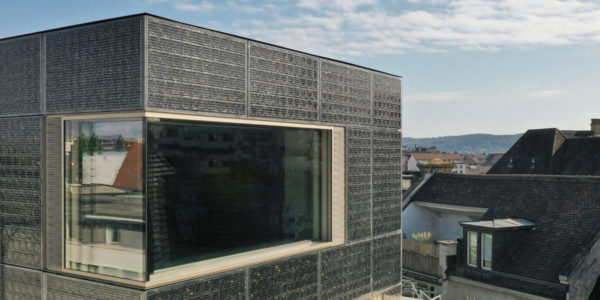From pv magazine Germany
The new building of the Office for Environment and Energy of Basel, in Switzerland, is 25 m high and completely encased in a solar façade that extends over 1,140 m2. The façade has an installed capacity of 163 kW and the shimmering golden solar modules used for the project lend the building a unique look.
The idea dates back to 2013 when local architectural firm Jessenvolleweider won a competition with its design proposal. In 2016, a referendum enabled the construction of the sustainable building, which was officially opened at the beginning of November. The original project envisaged the use of solar modules comprised of golden solar cells; however, a different approach was eventually employed, which used a new solar module fabricated with a special fused glass from Megasol Energie AG.
“The ability of this glass to take on different appearances under different light situations was the basis for our research,” said Sven Kowalewsky from Jessenhlenweider. “And the free design options for fused glass were the decisive factor.” The solar modules are designed in such a way that they form the outer skin of the new building. Viewed from a distance, the façade takes on a golden sheen, which is created by thousands of points embedded in the solar modules. In addition, the modules have a three-dimensional appearance.
“We developed these solar modules in close cooperation with the architect,” said Megasol Energie's spokesperson, Michael Reist. The solar modules installed in the building are made with a rear side glass, an encapsulation layer, solar cells, another encapsulation layer, and the 3D front glass. Megasol then assembles the components into one unit in a laminator. “Each solar module was developed specifically for the project, which requires appropriate adjustments and readjustments during manufacturing,” Reist said.

Image: Megasol Energie AG
An additional challenge in the production of the solar modules is that 3D fused glass has a three-dimensional structure on both the front and back. “Standard processes are designed for ‘flat’ glasses and cannot absorb such modifications, especially in the lamination,” he continued. “Lamination is a sensitive process and the smallest change in temperature, pressure, processing time or material properties lead to undesirable results.”
Megasol applied a process specifically adapted to 3D glasses with an appropriate lamination technique with regard to temperature, pressure, and processing time. This process is crucial for the quality, performance, and longevity of the solar modules.
In addition to its unique appearance, the solar façade in Basel has another advantage: According to Megasol, it also produces a lot of solar power in winter. This is due to the fact that solar façade surfaces are ideally suited to the low winter sun, as the light falls almost perpendicularly onto the solar cells. “Together with the cold air, which increases the efficiency of the cells, these are very good conditions,” said Reist.
This content is protected by copyright and may not be reused. If you want to cooperate with us and would like to reuse some of our content, please contact: editors@pv-magazine.com.




4 comments
By submitting this form you agree to pv magazine using your data for the purposes of publishing your comment.
Your personal data will only be disclosed or otherwise transmitted to third parties for the purposes of spam filtering or if this is necessary for technical maintenance of the website. Any other transfer to third parties will not take place unless this is justified on the basis of applicable data protection regulations or if pv magazine is legally obliged to do so.
You may revoke this consent at any time with effect for the future, in which case your personal data will be deleted immediately. Otherwise, your data will be deleted if pv magazine has processed your request or the purpose of data storage is fulfilled.
Further information on data privacy can be found in our Data Protection Policy.